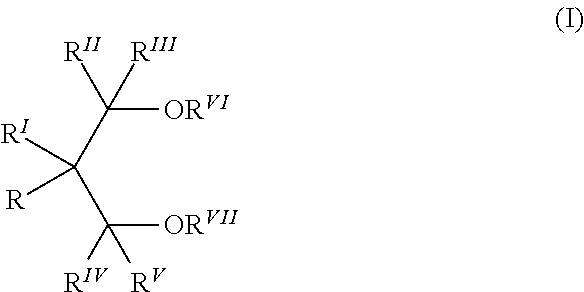Magnesium dichloride-alcohol adducts and catalyst components obtained there-from
a technology of magnesium dichloride and catalyst components, applied in the direction of magnesium organic compounds, etc., can solve the problems of substantially negatively affecting the bulk density of the polymer, and achieve the effect of reducing polymer breakage and increasing morphological stability
- Summary
- Abstract
- Description
- Claims
- Application Information
AI Technical Summary
Benefits of technology
Problems solved by technology
Method used
Image
Examples
example 1
[0044]A 1 liter reactor was loaded with 100 g of anhydrous MgCl2, 144 g of EtOH, and 5 g of Mg(CH3COO)2*4H2O The temperature was raised up to 125° C. and kept at this value for 5 hours. After that, the resulting melt was emulsified with ROL OB55 AT vaseline oil continuously introduced at 125° C. in an emulsifier, the stirring was brought to 1500 rpm and kept at that value for five minutes while continuously feeding the obtained emulsion into a stirred reactor containing cold hexane under stirring at 1000 rpm.
[0045]The solid spherical catalyst support is then crystallized washed and dried, collecting a material having a composition of 54.6% EtOH, 11.1% Mg, 32.4% Cl by weight and a P50 of 55 micron.
[0046]The solid catalyst component was prepared by following the procedure below.
[0047]Preparation of the Solid Catalyst Component
[0048]Into a 2 liter steel reactor provided with stirrer, 1500 cm3 of TiCl4 at 0° C. were introduced; at room temperature and whilst stirring 45 g of the above a...
example 2
[0052]The same procedure described fore the preparation of the support of example 1 was repeated with the difference that 4 grams of Mg(t-BuO)2 was used instead of Mg(CH3COO)2. The final adduct had P50 particle size of 61.4 μm. The catalyst was prepared and the polymerization test was carried out as described in Example 1. The polymerization results are reported in table 1.
example 3
[0053]The same procedure described for the preparation of the support of example 2 was repeated with the difference that 8 grams of Mg(t-BuO)2 was used instead of Mg(CH3COO)2. The final adduct had P50 particle size of 78.7 μm. The catalyst was prepared and the polymerization test was carried out as described in Example 1. The polymerization results are reported in table 1.
Comparative 2
[0054]The same procedure described for the preparation of the support of example 2 was repeated with the difference that Mg(t-BuO)2 was not used. The final adduct had P50 particle size of 74.1 μm. The catalyst was prepared and the polymerization test was carried out as described in Example 1. The polymerization results are reported in table 1.
[0055]
TABLE 1ActivityXylene Insol.Bulk DensityBreakagesExampleKg / g%g / cm3%166.097.60.4473.3Comp. 170.097.70.4285.5271.597.90.4514.1363.297.80.4344.5Comp. 277.398.20.4176.5
PUM
| Property | Measurement | Unit |
|---|---|---|
| molar ratio | aaaaa | aaaaa |
| molar ratio | aaaaa | aaaaa |
| molar ratio | aaaaa | aaaaa |
Abstract
Description
Claims
Application Information
 Login to View More
Login to View More - R&D
- Intellectual Property
- Life Sciences
- Materials
- Tech Scout
- Unparalleled Data Quality
- Higher Quality Content
- 60% Fewer Hallucinations
Browse by: Latest US Patents, China's latest patents, Technical Efficacy Thesaurus, Application Domain, Technology Topic, Popular Technical Reports.
© 2025 PatSnap. All rights reserved.Legal|Privacy policy|Modern Slavery Act Transparency Statement|Sitemap|About US| Contact US: help@patsnap.com

